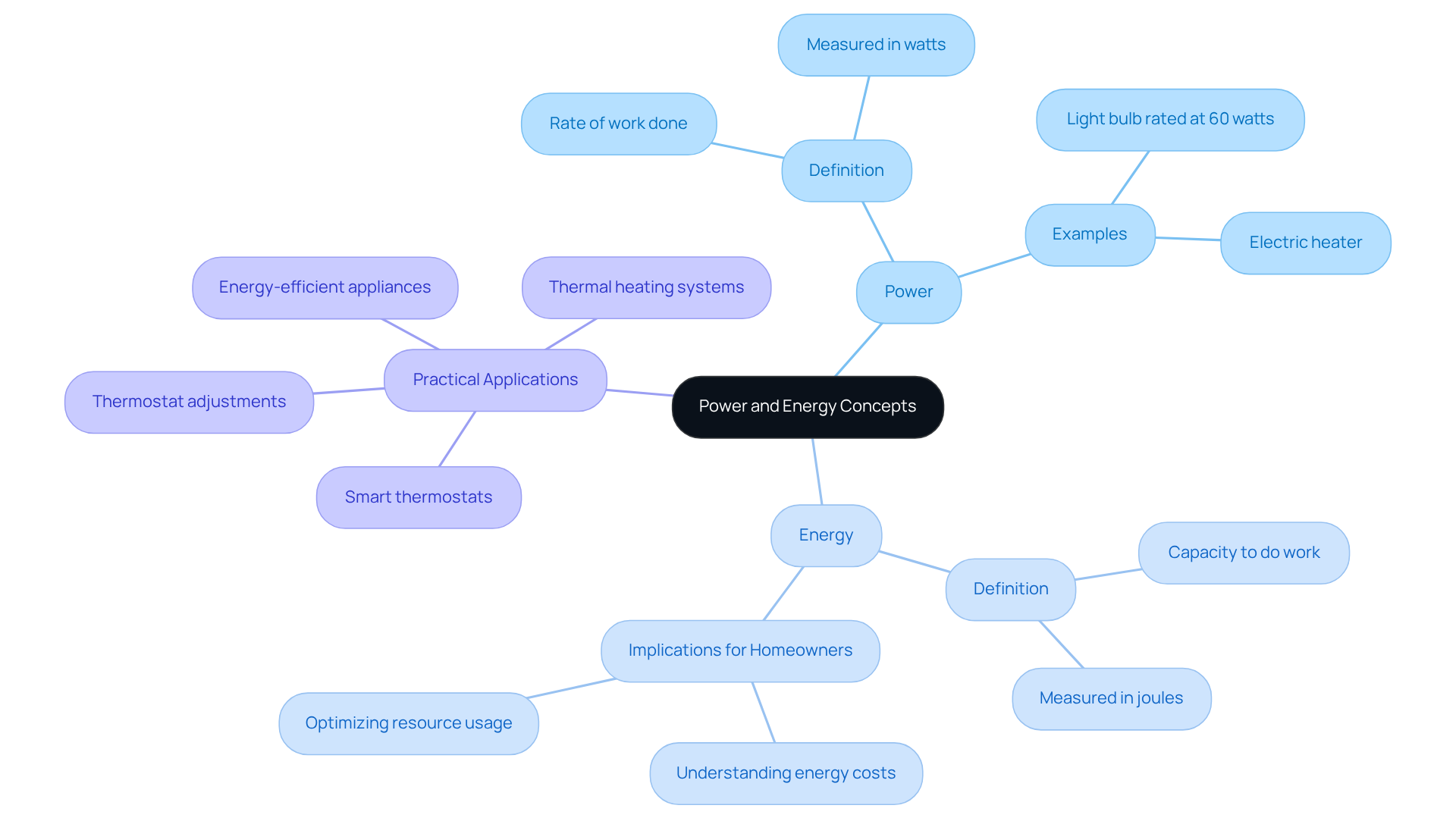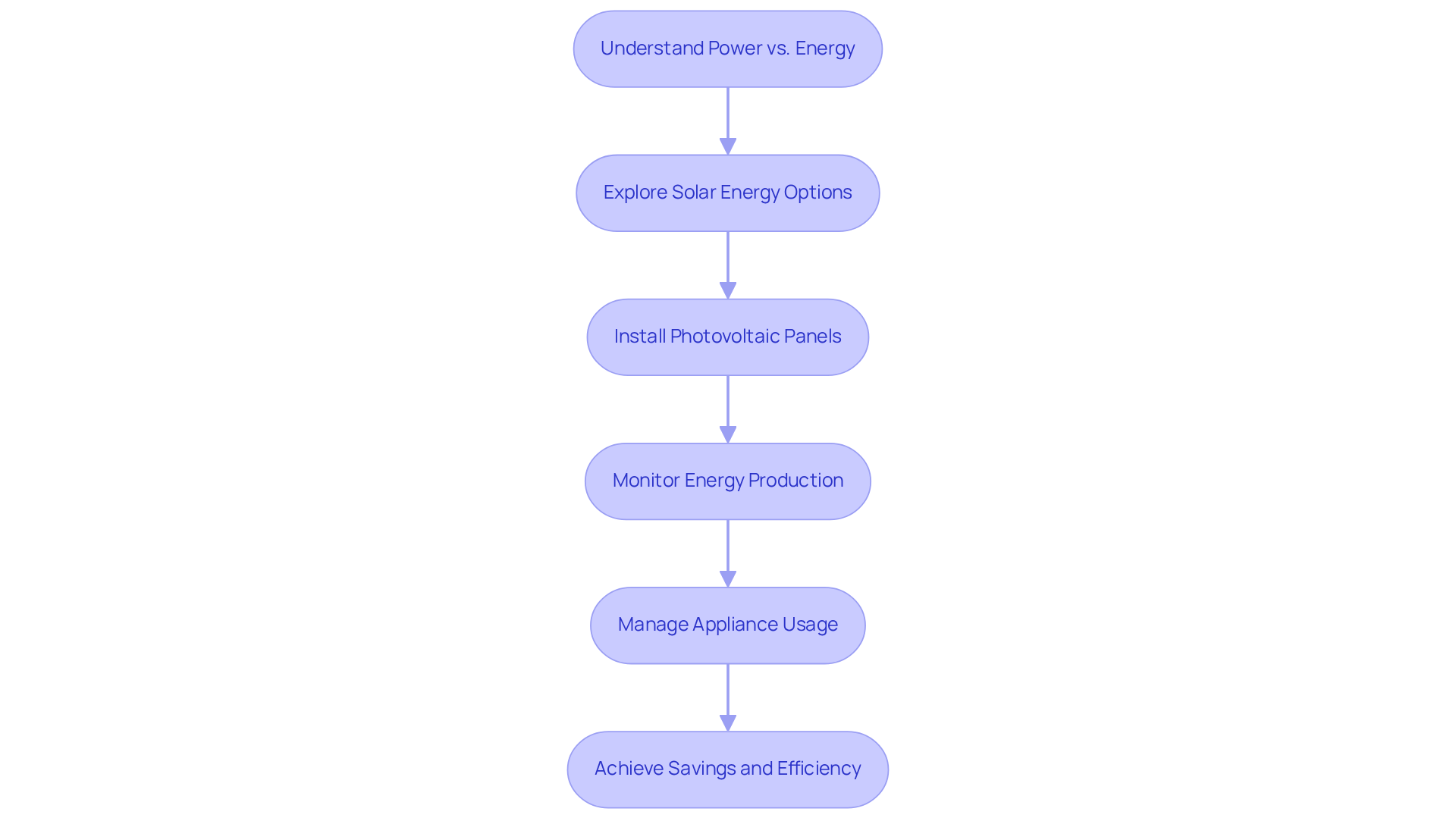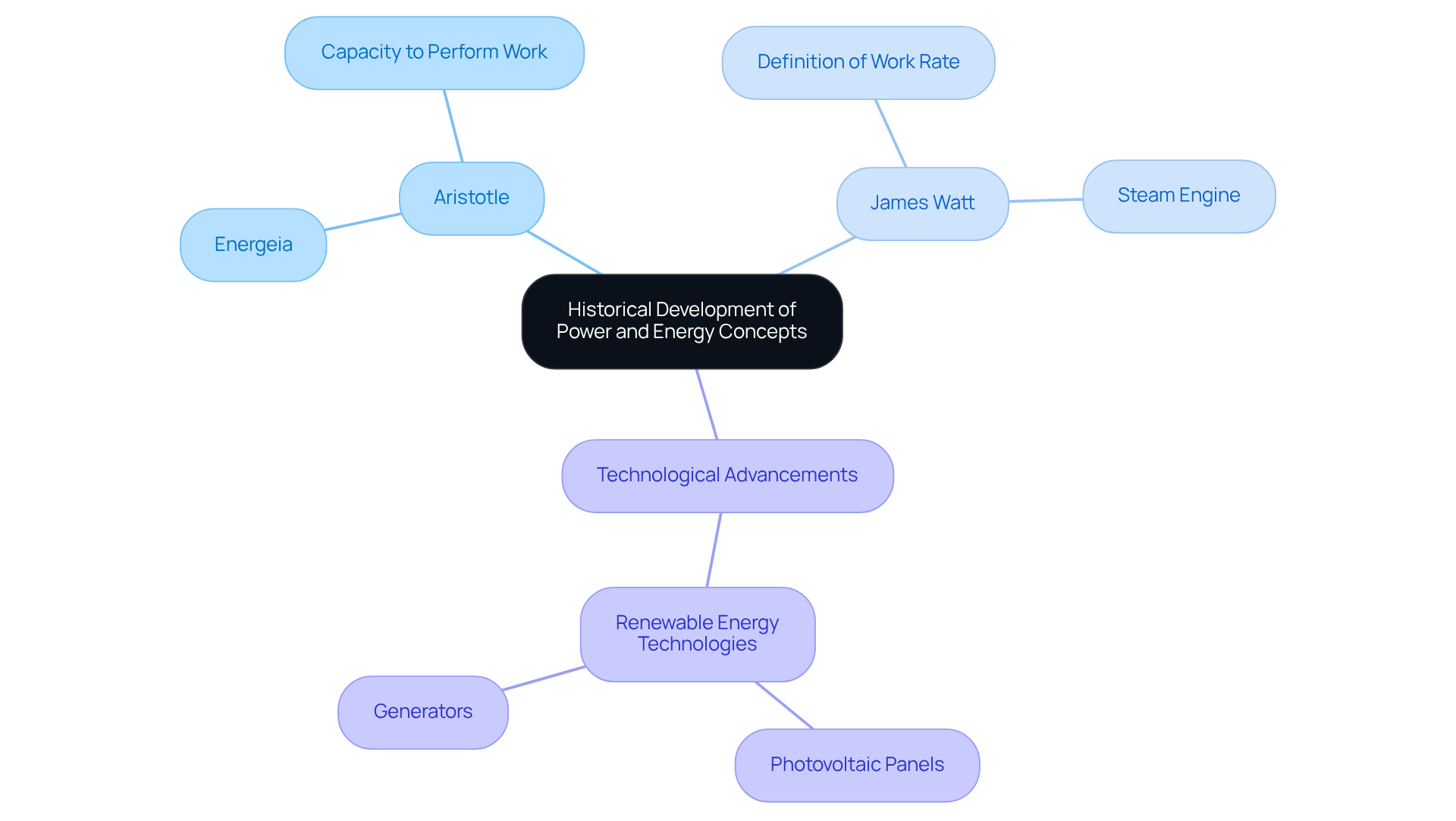Overview
We understand that many homeowners are concerned about rising energy bills and the impact they have on your finances. The difference between power and energy is essential to grasp: energy is the capacity to do work, measured in joules or watt-hours, while power is the rate at which energy is used or generated, measured in watts or kilowatts. Understanding these concepts can lead to better resource management and significant cost savings. By embracing energy-efficient appliances and renewable energy solutions like solar panels, you can take meaningful steps towards energy independence.
Imagine the relief of seeing your energy costs decrease while contributing to a healthier planet. The benefits of solar energy not only help you save money but also empower you to take control of your energy usage. It’s common to feel overwhelmed by the choices available, but you’re not alone in this journey. Together, we can explore sustainable solutions that fit your lifestyle.
Let’s work towards a future where your energy needs are met efficiently and affordably. If you’re ready to take the next step, we’re here to support you every step of the way. Contact us today to learn how we can help you achieve your energy goals.
Introduction
In a time when energy costs are climbing, we understand how crucial it is for homeowners to grasp the fundamental differences between power and energy. While these terms are often used interchangeably, they represent distinct concepts that can greatly influence household efficiency and expenses.
Have you ever wondered if understanding these differences could lead to significant savings and a more sustainable lifestyle? This article explores the nuances of power and energy, offering insights that empower you to make informed decisions about your energy consumption and management.
Together, we can navigate these complexities and work towards a more energy-independent future.
Define Power and Energy: Core Concepts Explained
Power and vitality, though often used interchangeably in everyday conversations, represent distinct concepts in physics, prompting the question of what is difference between power and energy that homeowners need to understand. Energy is the capacity to do work, measured in joules (J) or watt-hours (Wh), indicating the total amount of work that can be accomplished. On the other hand, capacity refers to the rate at which force is transferred or converted, measured in watts (W) or kilowatts (kW). In essence, power signifies how quickly resources are utilized or generated. For example, a light bulb rated at 60 watts consumes power at a rate of 60 joules per second. Understanding what is difference between power and energy is crucial for homeowners who wish to optimize resource usage and manage their expenses effectively.
In California, the typical household consumes approximately 542 kWh each month, underscoring the importance of grasping these concepts for efficient resource management. Homeowners can take steps such as:
- Upgrading to energy-efficient appliances
- Employing smart thermostats to enhance their consumption
By adjusting thermostat settings, for instance, households can save between 5-15% on heating and cooling costs, illustrating how understanding power can lead to practical benefits in everyday life.
Additionally, incorporating thermal heating systems can further boost energy efficiency. Active heating systems use pumps and controls to circulate heat transfer fluids, while passive methods rely on architectural design to harness sunlight. Understanding the differences among these systems empowers homeowners to choose the best option for their specific needs. Moreover, solar heating solutions can lead to significant financial advantages, including lower utility bills and a reduced carbon footprint, making them an attractive choice for environmentally conscious homeowners. Together, we can work towards a more sustainable future.
Explore the Practical Implications of Power and Energy in Home Use
In today’s world, many homeowners share concerns about rising energy bills and the impact on their finances. We understand that this can be a source of stress, especially for those who are environmentally conscious and seeking sustainable solutions. By understanding what is the difference between power and energy, you can achieve significant savings and enhance your home’s efficiency, particularly if you’re exploring renewable options like solar energy.
When you install photovoltaic panels, you generate electricity—measured in kilowatt-hours—that can power your home. The capacity rating of your solar setup, measured in kilowatts, determines how much electricity can be produced at any moment. This is crucial for maximizing your energy consumption under the 200% rule. It’s important to consider both the total usage of your devices and their ratings to fully benefit from your solar installation. For instance, using multiple high-power appliances simultaneously can increase the demand on your electrical system, potentially leading to higher utility costs.
By managing the timing of your appliance usage and understanding your solar panel’s capacity, you can reduce peak electricity demand, improve efficiency, and ultimately save on expenses. Together, we can work towards a more sustainable future, ensuring that your home not only meets your energy needs but also aligns with your values. Let’s take this journey towards energy independence together, where we can support each other in making informed choices that benefit both your household and the environment.
Trace the Historical Development of Power and Energy Concepts
We understand that many homeowners are concerned about rising energy bills and the impact they have on their budgets. The concepts of strength and vitality have evolved significantly over the centuries, and today, the term ‘energy’ is more relevant than ever. Originating from the Greek word ‘energeia,’ which Aristotle used to describe the capacity to perform work, the understanding of energy has deepened, especially with the contributions of 19th-century scientists like James Watt, who defined it as the rate of performing work. This advancement led to the creation of the steam engine and the industrial revolution, fundamentally altering consumption patterns.
As electricity emerged as a primary source in the 20th century, the distinction between strength and vitality became increasingly significant, particularly in household usage. Today, with the rise of renewable power technologies—such as photovoltaic panels and generators—homeowners, especially those environmentally conscious in places like Long Beach, are empowered to manage their power consumption more efficiently than ever before. Understanding the capacity ratings of these systems and the total resources they utilize is essential for maximizing both the financial and ecological benefits of heating systems.
This knowledge not only aids in integrating efficiency but also fosters long-term sustainability. It’s common to feel overwhelmed by the options available, but together we can explore how solar power solutions can meet your needs. By enhancing your understanding of energy, you can take meaningful steps towards energy independence and contribute to a healthier planet, while also exploring what is the difference between power and energy. Let’s work towards a brighter, sustainable future together.
Identify Key Characteristics: Distinguishing Power from Energy
To differentiate between power and vitality, we need to understand what is difference between power and energy by recognizing their key characteristics. Energy is a scalar quantity, meaning it has magnitude but no direction, and is measured over time. It accumulates and can be stored, such as in batteries or thermal storage systems. For instance, California has experienced a notable rise in residential power storage capacity, expanding from 500 megawatts in 2018 to more than 15,700 megawatts by early 2025. This indicates the increasing need for independence among homeowners, especially as energy bills continue to rise.
Power, conversely, is the rate of transfer and is assessed at a particular point in time. It is a vector quantity, indicating both magnitude and direction. For example, when a solar panel setup is rated at 5 kW, it means it can produce 5 kilowatts of power at peak sunlight. If it functions for 5 hours, it produces 25 kWh of power. For homeowners aiming to enhance their power solutions, understanding what is difference between power and energy is essential. By understanding these characteristics, they can better assess their energy needs and implement effective solutions. Imagine integrating energy storage systems that allow you to maximize the use of excess solar power and reduce reliance on the grid—together, we can work towards a more sustainable future. Let’s explore how these options can benefit you and your family.
Conclusion
Understanding the distinction between power and energy is essential for homeowners who are concerned about optimizing their resource usage and managing energy costs effectively. We understand that energy bills can be overwhelming, and while power refers to the rate at which energy is consumed or generated, energy itself is the total capacity to perform work. This knowledge empowers you to make informed choices that lead to enhanced efficiency and reduced expenses, particularly in an era of rising energy bills.
Throughout this article, we have highlighted key insights, such as:
- The importance of upgrading to energy-efficient appliances
- Employing smart technologies
- Understanding the capacities of renewable energy systems like solar panels
By grasping these concepts, you can not only lower your utility bills but also contribute to a more sustainable future by making eco-friendly choices in your energy consumption.
In summary, the journey towards energy independence starts with knowledge. By recognizing the differences between power and energy, you can take actionable steps to improve your energy efficiency and reduce your environmental impact. Embracing energy-efficient practices and renewable solutions is not just beneficial for your personal finances; it plays a crucial role in fostering a healthier planet. Together, let this understanding inspire a commitment to smarter energy choices and a more sustainable lifestyle. Remember, we are here to support you on this journey.






